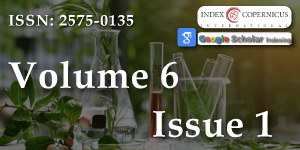Growth performance of selected Moringa oleifera seed origins in North Florida
Main Article Content
Abstract
Moringa oleifera which is also known as horseradish or drumstick tree is a rapidly growing, drought-tolerant tree that can tolerate poor soil conditions. It is presently broadly cultivated and has turned out to be naturalized in numerous geographical areas of the tropics. The objective of this study was to evaluate the growth performance and survivability of Moringa seed origins in the North Florida region of the United States of America. Seedlings were prepared in the George Conoly Greenhouse at the Florida A&M University, Tallahassee, FL. The seed origins were Ghana, Texas PKM1, Haiti PKM1, Colombia, Nigeria, Jamaica, Nigeria Local, Impex PKM1, Peela Medu, India EOA PKM1, and Belton. A randomized completely block design (RCBD) was used in this study to compare the performance of eleven seed origins of M. oleifera Height and Stem diameter. Nigeria Local had the best performance in terms of height for 2018 and 2019 growing seasons, 191.98 ± 7.42 cm and 123.19 ± 26.67 cm, respectively. Colombia had the best performance in terms of stem diameter for the 2018 and 2019 growing seasons, 2.6 ± 0 cm and 2.08 ± 0 cm, respectively. However, DMRT revealed that the height and stem diameter of the seed origins were not significantly different (p ≤ 0.05). Therefore, the results revealed that the alternative hypotheses (Ha) that the Moringa oleifera seed origins were significantly different in heights and stem diameter were rejected.
Article Details
Copyright (c) 2022 Olaborode OS, et al.

This work is licensed under a Creative Commons Attribution 4.0 International License.
The Journal of Plant Science and Phytopathology is committed in making it easier for people to share and build upon the work of others while maintaining consistency with the rules of copyright. In order to use the Open Access paradigm to the maximum extent in true terms as free of charge online access along with usage right, we grant usage rights through the use of specific Creative Commons license.
License: Copyright © 2017 - 2025 |  Open Access by Journal of Plant Science and Phytopathology is licensed under a Creative Commons Attribution 4.0 International License. Based on a work at Heighten Science Publications Inc.
Open Access by Journal of Plant Science and Phytopathology is licensed under a Creative Commons Attribution 4.0 International License. Based on a work at Heighten Science Publications Inc.
With this license, the authors are allowed that after publishing with the journal, they can share their research by posting a free draft copy of their article to any repository or website.
Compliance 'CC BY' license helps in:
| Permission to read and download | ✓ |
| Permission to display in a repository | ✓ |
| Permission to translate | ✓ |
| Commercial uses of manuscript | ✓ |
'CC' stands for Creative Commons license. 'BY' symbolizes that users have provided attribution to the creator that the published manuscripts can be used or shared. This license allows for redistribution, commercial and non-commercial, as long as it is passed along unchanged and in whole, with credit to the author.
Please take in notification that Creative Commons user licenses are non-revocable. We recommend authors to check if their funding body requires a specific license.
Alhakmani F, Kumar S, Khan SA. Estimation of total phenolic content, in-vitro antioxidant and anti-inflammatory activity of flowers of Moringa oleifera. Asian Pac J Trop Biomed. 2013; 3: 623-627. PubMed: https://pubmed.ncbi.nlm.nih.gov/23905019/
Faley JW. Medicinal potential and benefits of Moringa oleifera 13.1 Moringa oleifera medicinal potential and benefits. The Miracle Tree: Moringa oleifera. 2019.
Omonhinmin C, Olomukoro E, Ayoola A, Egwim E. Utilization of Moringa oleifera oil for biodiesel production: A systematic review. AIMS Energy. 2020; 8: 102.
Li X, Siddique KH. Future smart food. Rediscovering hidden treasures of neglected and underutilized species for Zero Hunger in Asia. FAO Bangkok. 2018.
Zaku SG, Emmanuel S, Tukur AA, Kabir A. Moringa oleifera: An underutilized tree in Nigeria with amazing versatility: A review. Afr J Food Sc. 2015; 9: 456-461.
Saini R. Dietary iron supplements and Moringaoleifera leaves influence the liver hepcidinmessenger RNA expression and biochemical indices of iron status in rats. Nutr Res. 2014; 34: 630–638. PubMed: https://pubmed.ncbi.nlm.nih.gov/25150122/
Arora DS, Onsare JG, Kaur H. Bioprospecting of Moringa (Moringaceae): microbiological perspective. J Pharmacognosy Phytochemistry. 2013; 1: 193- 215.
Kirschbaum MUF. Direct and indirect climate change effects on photosynthesis and transpiration. Plant Biology. 2004; 6: 242-253.
Pokhrel CP, Timilsina A, Yadav RKP, Khanal R. Moringa Oleifere: A potential cash crop in Nepal. In International symposium on healthy society & healthy world.2016; 33–41.
Asante WJ, Nasare IL, Tom-Dery D, Ochire-Boadu K, Kentil KB. Nutrient composition of Moringa oleifera leaves from two agro ecological zones in Ghana. Afr J Plant Sci. 2014; 8: 65–71.
Korsor M, Ntahonshikira C, Bello HM, Kwaambwa HM. Comparative proximate and mineral composition of Moringa oleifera and Moringa ovalifolia grown in central Namibia. Sustainable Agri Res. 2017; 6: 31.
Lawrimore J. Global Summary of the Year, Version 1.0. NOAA National Centers for Environmental Information. 2016. https://www.currentresults.com/YearlyWeather/USA/FL/Tallahassee/recent-annual-tallahassee-temperature-precipitation.php
Billings WD. Constraints to plant growth, reproduction, and establishment in arctic environments. Arctic Alpine Res. 1987; 19: 357-365.
Korsor M, Ntahonshikira C, Kwaambwa HM, Bello HM. Comparative performance of Moringa oleifera and Moringa ovalifolia seeds and seedlings establishment in central Namibia. Net J Agri Sci. 2016; 4: 35-44.
Padayachee B, Baijnath H. An overview of the medicinal importance of Moringaceae. J Med Plants Res. 2012; 6: 5831-5839.
Hassan FAG, Ibrahim MA. Moringa oleifera: nature is most nutritious and multi-purpose tree. Int J Sci Res Publications. 2013; 3: 1-5.
Sánchez NR, Ledin S, Ledin I. Biomass production and chemical composition of Moringa oleifera under different management regimes in Nicaragua. Agrofores Sys. 2006; 66: 231-242.

